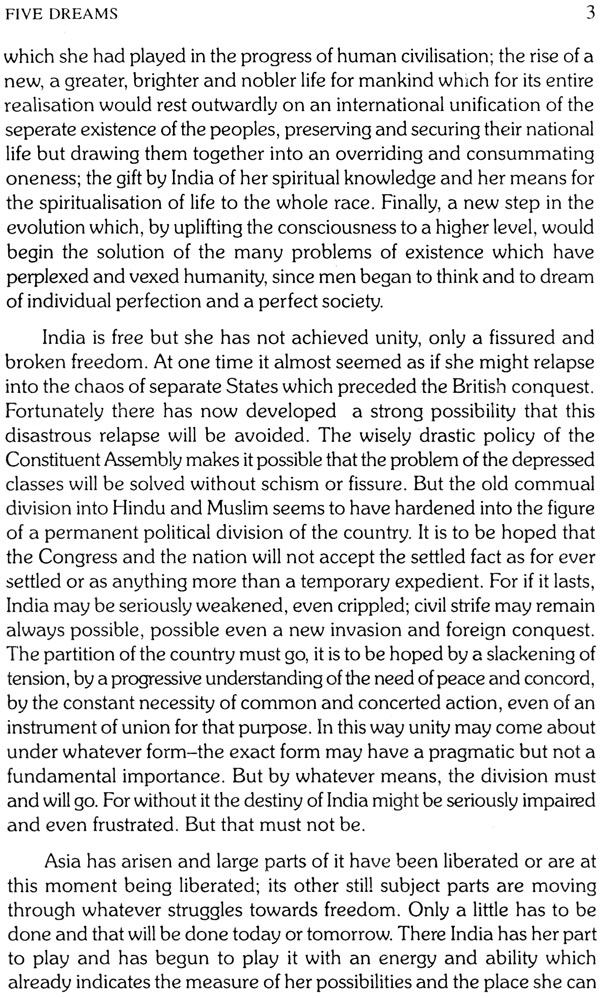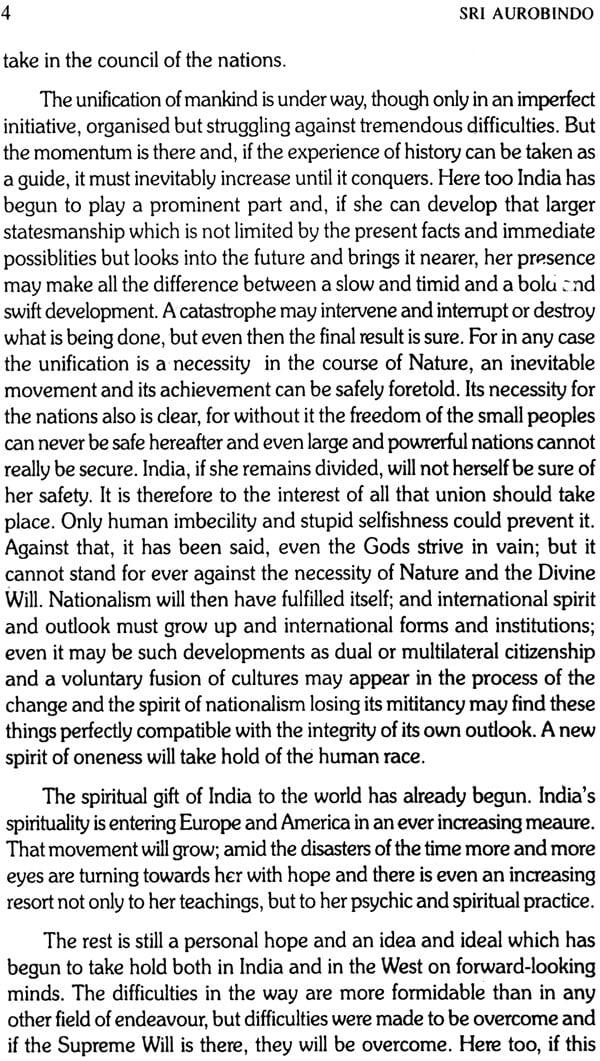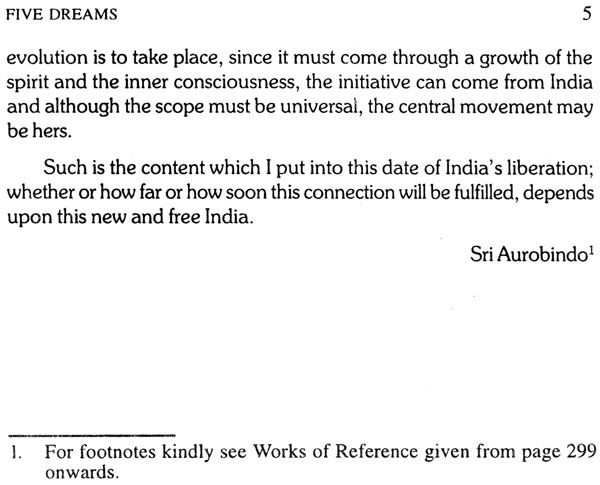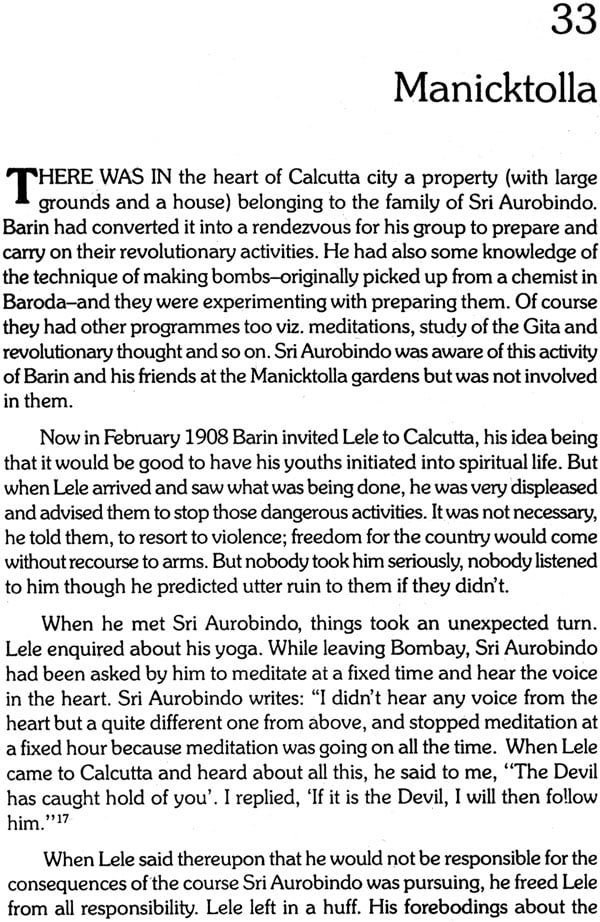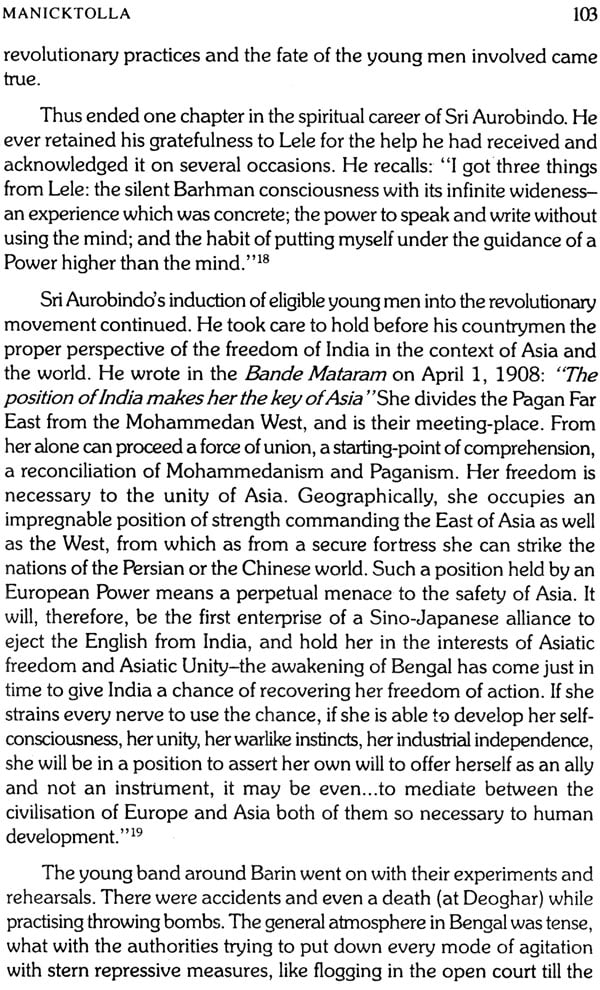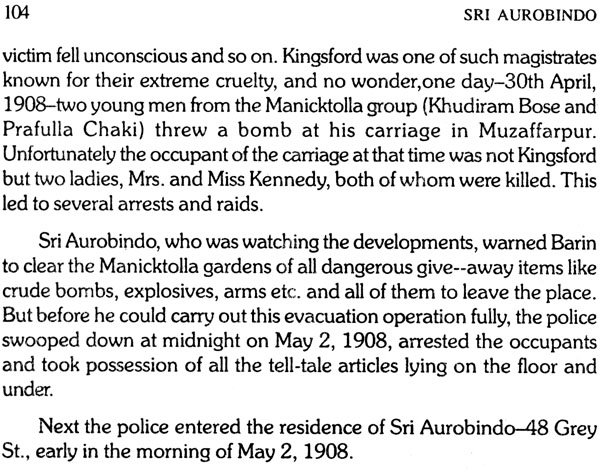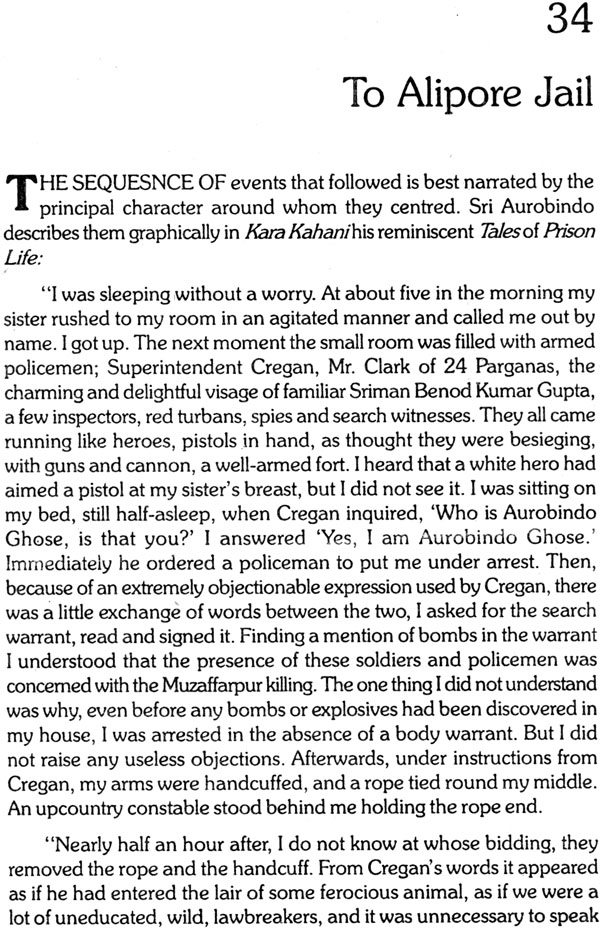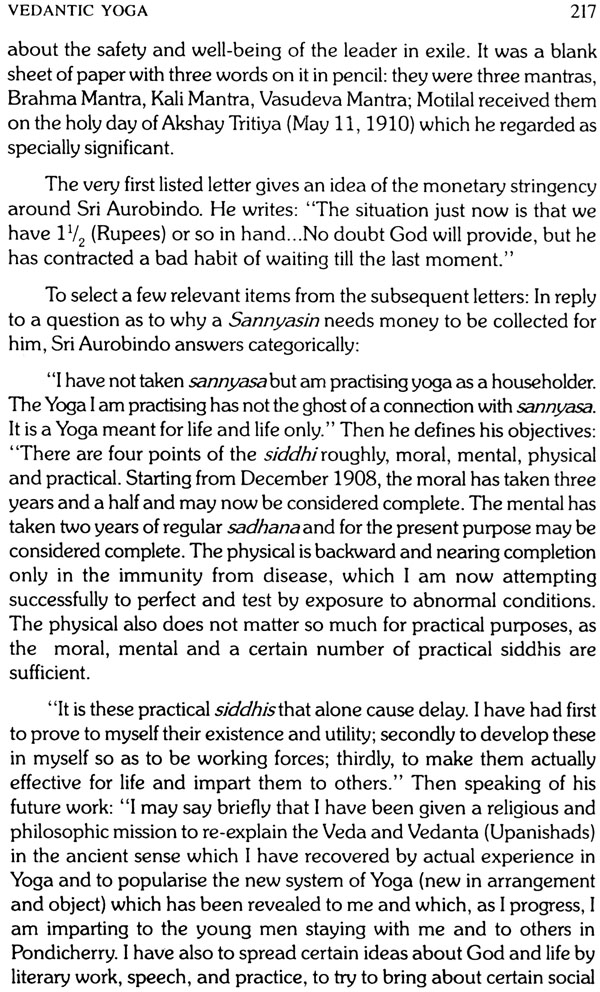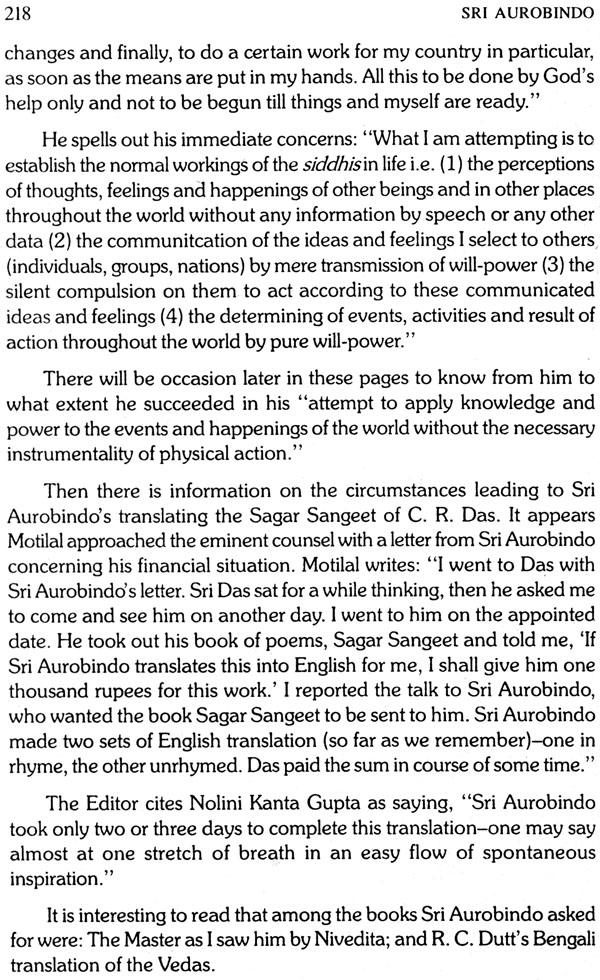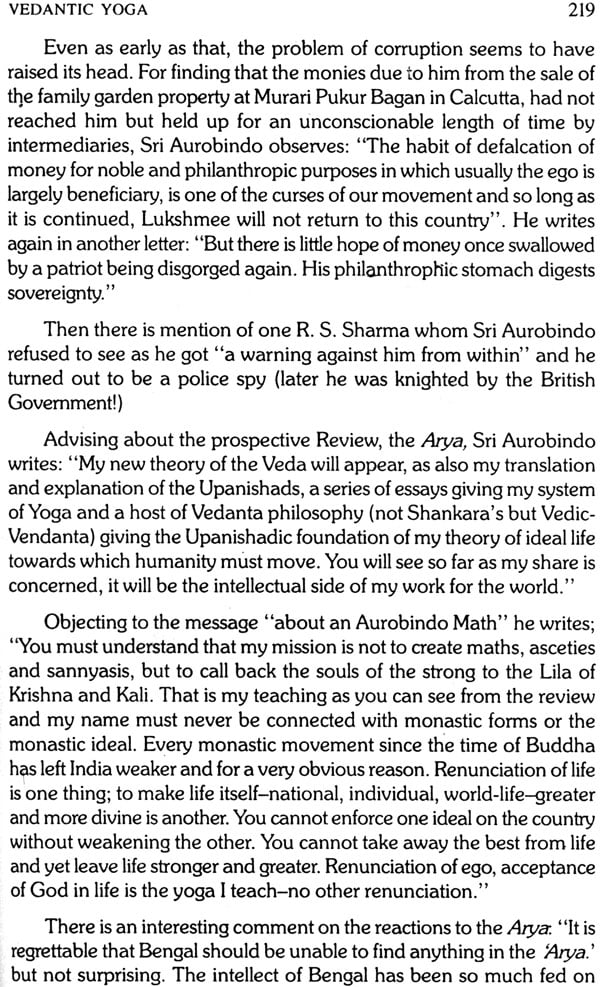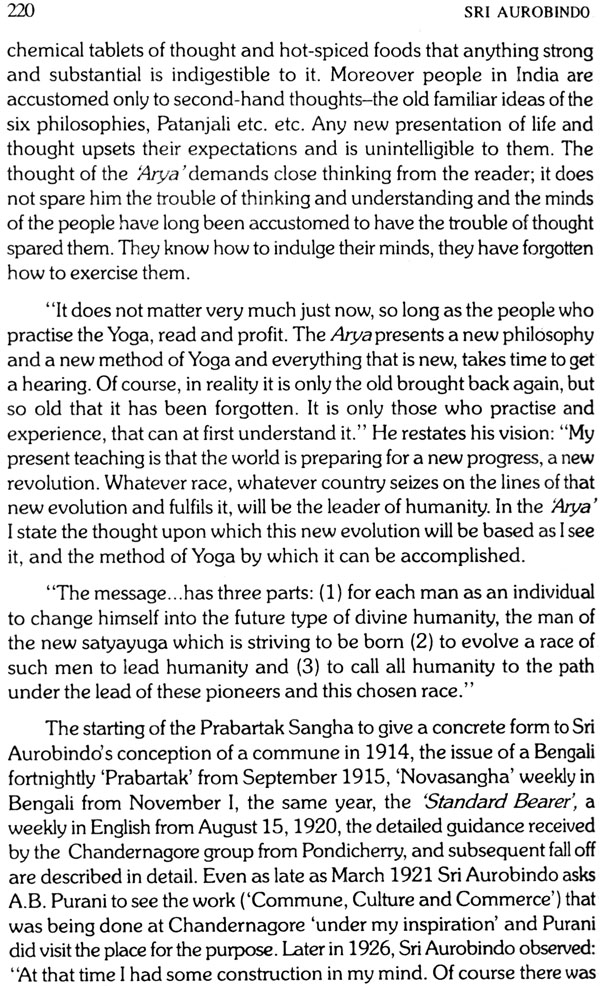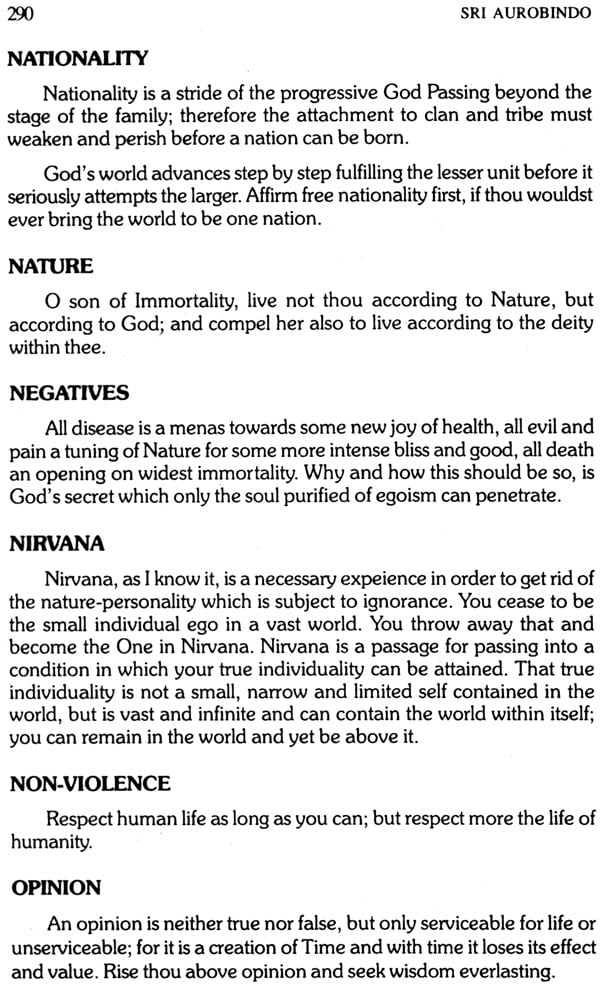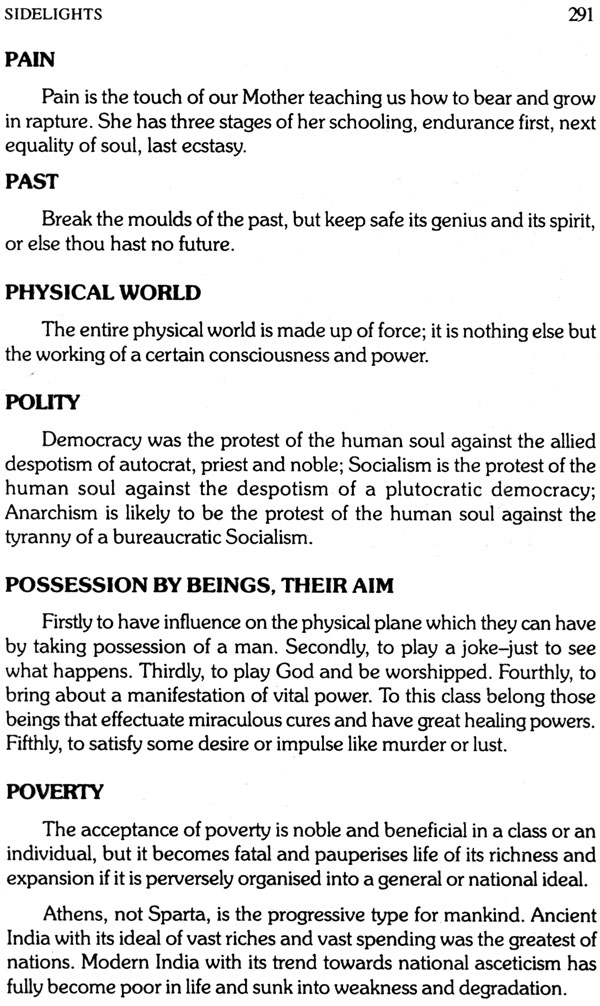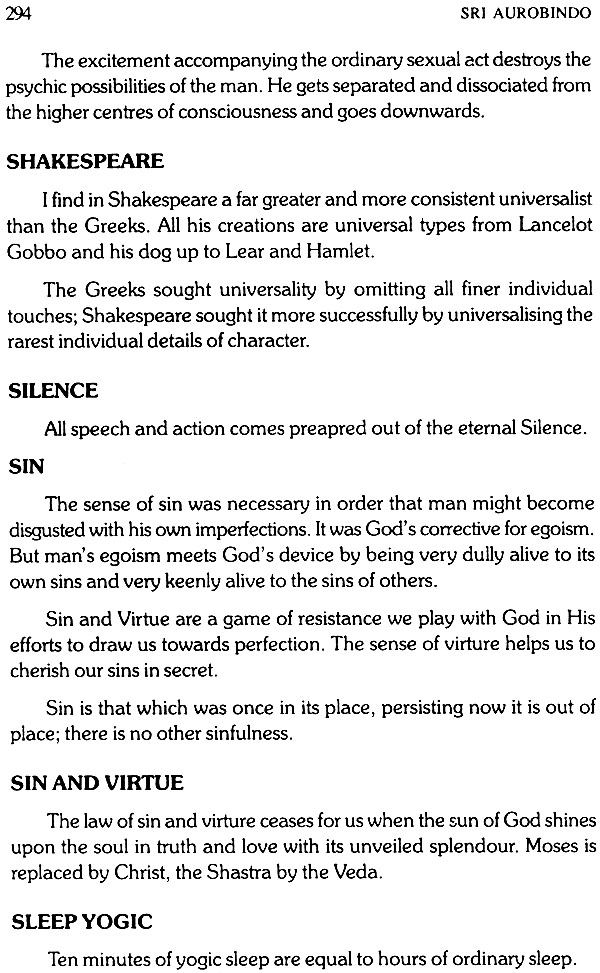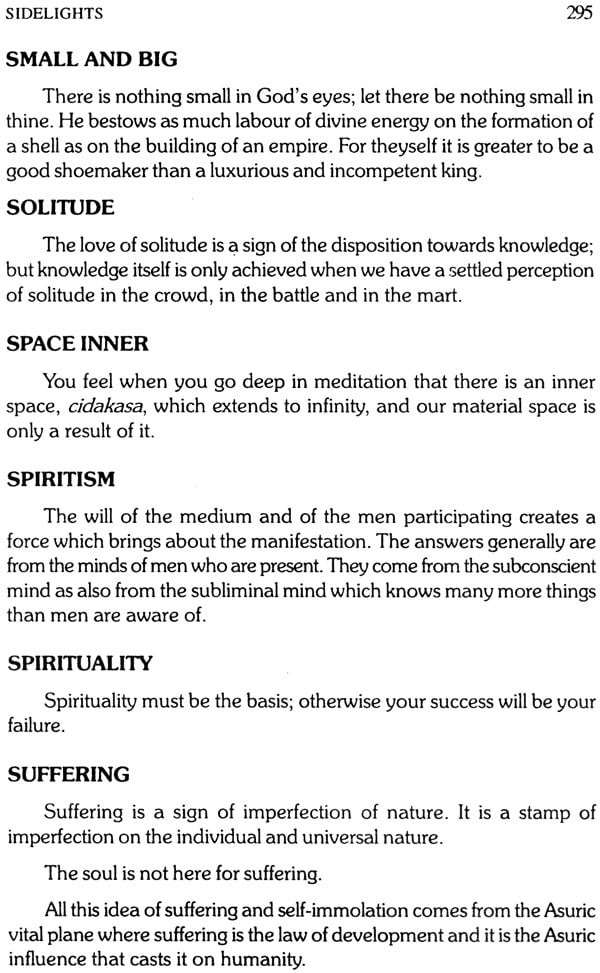
Sri Aurobindo
Book Specification
| Item Code: | IDE702 |
| Author: | M.P. Pandit |
| Publisher: | Publications Division, Government of India |
| Language: | English |
| Edition: | 2021 |
| ISBN: | 9789354092558 |
| Pages: | 328 |
| Cover: | Paperback |
| Other Details | 8.5" X 5.6" |
| Weight | 440 gm |
Book Description
My first contact with Sri Aurobindo took place in a strange way. I was thirteen. One afternoon I was idly browsing among books in the office-cum-library of my brother who was an advocate. The dusty book- shelves were full of old leather bound volumes of All-India Law Reports. Among them was a big green book which excited my curiosity. I pulled it out and found it was entitled. "Alipore Bomb Case". I opened it and my eyes fell on a photograph with the words ARAVINDA GHOSE beneath. The name acted on me like a mantra and I found myself repeating it with obvious delight. It was something sweet and melodious. Later I spoke to my brother of this experience. He wrote about it to my mentor Sri Kapali Sastry who told me that the meaning of my finding the photograph in the book would become evident as I grew up. And so it did.
For soon my childhood impulses towards God grew into a hunger and I devoured the Gospel of Sri Ramakrishna, the works of Swami Vivekananda and so on. I asked Sri Kapali Sastry whether I could go to Pondicherry and join him there. He was definite that I should continue my education and prepare myself for the Quest in the meanwhile. By that time the Bases of Yoga by Sri Aurobindo had been published. It was a beautiful bound volume costing only three rupees and it became my companion.
Within a couple of years, in 1937, I had my first Darshan of Sri Aurobindo on August 15. It was overwhelming and I felt the only thing comparable to him was the Himalayas. I still remember the slight smile on his face moulded of compassion.
Then in April 1939, on the eve of my coming away to the ashram, I had a curious desire to travel by plane from Bombay to Poona as I thought that once I joined the ashram I would not leave it and there would be no opportunity to travel by air thereafter. So I wrote to Pondicherry and Sri Aurobindo wrote in pencil, 'He can fly'. That was his first communication to me and it thrilled me to the core. I mattered to him, didn't I?
The next occasion was some time in 1947 when I wrote my first article. It was on meditation and it was being read out to him, he remarked that he had heard it before. Nirodbaran who was reading it assured him that it was the first time that it had come up. But Sri Aurobindo insisted that he had heard every word of it. When I learnt of it, I felt so humble.
Yet another time, I had written a reply to Adhar Chandra Das's criticism of a book by Sri Aurobindo in the Calcutta Review. Ongoing through it, Sri Aurobindo added a line: The physical mind also thinks. It opened a vista for me.
I mention these few incidents as outer tokens of a relation that developed steadily and was made possible by the solicitude and grace of both Sri Aurobindo and the Mother. My being was completely taken over by his Personality whose diverse aspects appealed to me more than his Philosophy which took time to enter and reshape my mind.
He was so human. Once when his sister and other members of the household complained to him bitterly about the bad behaviour of the cook, he called him aside and said, in his usual impesonal tone. "It seems you are behaving rudely, do not do so." We do not know what the others felt; we only know that the culprit went away smiling.
He was so full of wit. When a British author wrote that Sri Aurobindo was a man who never smiles, Sri Aurobindo added, "but who always jokes."
He was so simple. When the ashram was formed and the mother took to him a list of things required for each Sadhaka, he was surprised and said that a sadhaka needs nothing more than a mat, a kuja and a thing or two that way. He did not understand why furniture like table, chair, cot, almirah was necessary. For he himself had all along managed in Pondicherry with the bare minimum. There was, for instance, just one towel among seven inmates of the house. Each one would use the towel after bath and hang it on the clothesline to dry. Sri Aurobindo would be the last to use it.
He was so undemanding. He would never ask anything for himself. During the Arya days he would be waiting for tea in the afternoons before starting typing for the Journal. One day the person incharge fell asleep and the tea failed to come up. Sri Aurobindo sat quietly waiting and did not call for it. Before his eyes came the figure of 4 in a golden hue. And precisely at 4 p.m. the apologetic attendant appeared with the tea.
He was so unprepossessing. He moved with all people as with equals. He frowned upon sadhakas scolding others and defended the right of every person to follow his nature.
He was so humble. He would learn from anyone, from anywhere. One day he was sitting in the Guest House verandah upstairs, in serious contemplation-obviously he had a problem. A familiar figure, Kulla Swami, as he was known, (a short non-descript ascetic with a none-too-good reputation) was passing by in the street below. Suddenly he turned, came up to where Sri Aurobindo was sitting, lifted a tea cup which was on the table, turned it upside down, put it right and was gone. Later Sri Aurobindo remarked that his difficulty had been solved: the cup has to be emptied before it is filled anew. No wounder the Mother once said that the only humble man she had met in her life was Sri Aurobindo.
It is this human side of Sri Aurobindo that I have attempted to present in these pages. Naturally in a multiple person like him, every aspect enters into every other and a plethora of radiant personalities comes up before our eye when we think of him. However, as of now, let us meet Sri Aurobindo the Man.
From the Jacket:
This Biography by Shri M.P. Pandit traces the evolution of Sri Aurobindo, the man and the saint, through his childhood, education in England, service in the State of Baroda, political activity and finally his dedication to spiritual sadhana.
(1872-1879)
| 1. | Five Dreams | 2 |
| 2. | The Dreamer | 6 |
| 3. | Ancestry | 8 |
| 4. | Childhood
| 10 |
| England (1879-1893) | ||
| 5. | Manchester | 14 |
| 6. | St. Paul's, London | 16 |
| 7. | Cambridge | 18 |
| 8. | Interest in Politics | 22 |
| 9. | Spiritual Awakenings | 24 |
| 10. | The Riding Test | 26 |
| 11. | Return to India
| 28 |
| Baroda (1893-1906) | ||
| 12. | Apollo Bunder | 32 |
| 13. | Service in Baroda | 33 |
| 14. | New Lamps for Old | 35 |
| 15. | Bankim Chandra Chatterjee | 39 |
| 16. | Being of Light | 43 |
| 17. | Visit to Family | 44 |
| 18. | At the College | 47 |
| 19. | Dinendra Kumar Roy | 50 |
| 20. | Literary Activity | 53 |
| 21. | Marriage and After | 55 |
| 22. | The Revolutionary Movement | 57 |
| 23. | Turn to Yoga | 63 |
| 24. | Mrinalini Letters | 67 |
| 25. | Bhawani Mandir | 75 |
| 26. | Gathering Storm
| 77 |
| Calcutta (1906-1910) | ||
| 27. | Bengal National College | 82 |
| 28. | Bande Mataram | 86 |
| 29. | Calcutta Congress Session : Swaraj | 90 |
| 30. | Bande Mataram Case | 91 |
| 31. | Fateful Surat Split | 95 |
| 32. | Lele and Nirvanic Experience | 99 |
| 33. | Manicktola | 102 |
| 34. | To Alipore Jail | 105 |
| 35. | Alipore Bomb Trial | 108 |
| 36. | Ashramvas in Alipore | 110 |
| 37. | Karmayogin | 118 |
| 38. | Chandernagore | 125 |
| 39. | A General Note on Sri Aurobindo's Political Life
| 129 |
| Pondicherry (1910-1950) | ||
| 40. | Arrival in Pondicherry | 148 |
| 41. | At Shankara Chetty's | 150 |
| 42. | Letter to The Hindu | 154 |
| 43. | "He knows Latin, He knows Greek" | 156 |
| 44. | Silent Yoga | 160 |
| 45. | Two shaved Heads Instead of One | 163 |
| 46. | The Arya | 165 |
| 47. | The Arya Sequences | 172 |
| 48. | Scriptures | 179 |
| 49. | Money-Power | 187 |
| 50. | India's Destiny | 190 |
| 51. | Great Peace and Serenity | 192 |
| 52. | Mrinalini Passes Away | 194 |
| 53. | India Will Be Free | 197 |
| 54. | Letter to Barin | 200 |
| 55. | Letter to Baptista | 210 |
| 56. | Return of the Richards | 214 |
| 57. | Vedantic Yoga and "Tantric Yoga" | 216 |
| 58. | Letter to Dr. Munje | 222 |
| 59. | "What Has Happened to You!" | 225 |
| 60. | Black Magic | 227 |
| 61. | Letter to C.R. Das | 232 |
| 62. | 9 Rue de la Marine | 235 |
| 63. | Dilip Kumar Roy-Devdas Gandhi | 238 |
| 64. | Lajpat Rai-Tandon | 240 |
| 65. | 24th November, 1926 | 242 |
| 66. | The Mother | 248 |
| 67. | Hearken to me | 251 |
| 68. | World War II | 254 |
| 69. | Cripps Mission | 257 |
| 70. | India is Free | 261 |
| 71. | Warnings on the World Situation | 268 |
| 72. | Ashram Developments | 271 |
| 73. | Savitri | 273 |
| 74. | Epilogue | 276 |
| Sidelights on Sri Aurobindo's Thought | 278 | |
| Works of Reference Cited in the Book | 299 | |
| Appendix | 305 | |
| Bibliography | 310 | |
| Chronology | 311 | |
| Index | 317 | |

